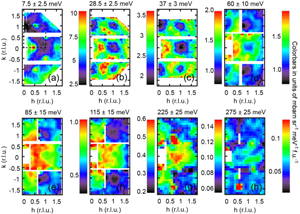Feb 8 2011
Neutron scattering analysis of two families of iron-based materials suggests that the magnetic interactions thought responsible for high-temperature superconductivity may lie "two doors down": The key magnetic exchange pairings occur in a next-nearest-neighbor ordering of atoms, rather than adjacent atoms.
Researchers at the Department of Energy's Oak Ridge National Laboratory and the University of Tennessee, using the Spallation Neutron Source's ARCS Wide Angular Range Chopper Spectrometer, performed spin-wave studies of magnetically ordered iron chalcogenides. They based their conclusions on comparisons with previous spin-wave data on magnetically ordered pnictides, another class of iron-based superconductors.
 This visual representation of neutron data from ORNL's Spallation Neutron Source shows the evolution of spin waves as a function of increasing energy for the iron chalcogenide FeTe. Experiments indicate high-temperature superconductivity in different materials may share a common magnetic origin.
This visual representation of neutron data from ORNL's Spallation Neutron Source shows the evolution of spin waves as a function of increasing energy for the iron chalcogenide FeTe. Experiments indicate high-temperature superconductivity in different materials may share a common magnetic origin.
"As we analyze the spectra, we find that even though the nearest neighbor exchange couplings between chalcogenide and pnictide atoms are different, the next nearest neighbor exchange couplings are closely similar," said Pengcheng Dai, who has a joint appointment with ORNL's Neutron Sciences Directorate and the University of Tennessee.
Dai referred to theories that have suggested second-nearest-neighbor couplings could be responsible for the widely acclaimed but poorly understood properties of high-temperature superconductors.
"There are theories suggesting that it's the second nearest neighbor that drives the superconductivity," he said. "Our discovery of similar next-nearest-neighbor couplings in these two iron-based systems suggests that superconductivity shares a common magnetic origin."
Oliver Lipscombe of the University of Tennessee, Dai and ORNL's Doug Abernathy used the ARCS time-of-flight instrument on the SNS to study spin waves of the chalcogenide iron-tellurium superconductor and compared these with iron pnictide superconductors.
Scientists have been studying the iron-based superconductors since their discovery in 2008 to see if the dynamics behind their high-temperature superconducting properties -- in which electricity flows without resistance at temperatures well above absolute zero -- could help explain what was until recently thought to be exclusive to copper-oxide-based superconductors.
"Finding commonalities is always a good step when you're looking for a very basic understanding of a phenomenon like high-temperature superconductivity," said Abernathy, who is lead instrument scientist for the ARCS instrument.
The team's neutron scattering analysis of the materials was made possible by the high intensity of the neutron beams provided by the SNS, which is the world's most powerful pulsed neutron source. Neutrons, which carry no electric charge but can act as subatomic magnets, are well suited for studying atom-scale spin characteristics.
"Since the interactions in the high-temperature superconductors are so strong, measurement of these materials' spin waves requires beams of energetic neutrons that were unavailable to the research community at this intensity before the SNS," Abernathy said.
The work, which was funded by the DOE Office of Science, is published in Physical Review Letters.